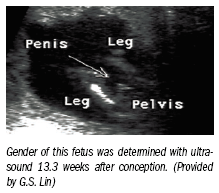Findings blow whistle on suspected gender selection
An abnormally low female birth rate among the Asian population in California's Santa Clara County may be closely related to the fetal keepsake ultrasound industry's growth in a region covering San Jose and the homes of nearly two million residents.
An abnormally low female birth rate among the Asian population in California's Santa Clara County may be closely related to the fetal keepsake ultrasound industry's growth in a region covering San Jose and the homes of nearly two million residents.
Study findings should alert policymakers about the need to regulate these facilities and investigate their possible role in facilitating a practice with powerful political, social, and cultural implications, according to the author.
"(The issue is) a matter of ethical concern when it comes to gender discrimination," said G. Sharap Lin, Ph.D., an ultrasound researcher and consultant for Advanced Imaging Associates, a radiology group in nearby Fremont.
Lin has done extensive research and lecturing on ultrasound's role in gender-selective abortions in Asia. He turned his attention to the U.S. when he heard anecdotal accounts that gender-selective abortions were taking place in Santa Clara County, an area with a large concentration of immigrants from Asia. Intrigued by what appeared to be an increasing number of fetal ultrasound keepsake facilities serving that community, he surveyed several of them.

Lin analyzed the birth gender ratio from annual birth statistics for California by county, race, and gender from 1995 to 2006 and correlated those findings with public access to unsupervised commercial keepsake ultrasound centers. The overall California birth gender ratio during that period averaged about 950 female children born per 1000 male.
The investigator found that, until 2003, the birth gender ratio for Asians in Santa Clara County had reflected the state average. By 2006, however, the birth gender ratio dropped to 902 female per 1000 male babies out of more than 8000 annually recorded births.
Santa Clara County is served by at least four 4D keepsake ultrasound centers established since 2002 that offer gender determination for an additional fee of $69 to $80. These facilities are operated by sonographers without daily physician supervision.
Lin presented study findings at the 2009 American Institute of Ultrasound in Medicine meeting in New York City.
Sonologists agree that the topic merits attention, but they question the study design and the quality of both the data. Linking four 4D keepsake imaging facilities, for instance, with birth gender ratio trends is "a big leap," according to Dr. Wesley Lee, an associate professor of ob/gyn at Wayne State University in Detroit.
"There are no statistical tests presented in the abstract that even support this possibility-let alone their conclusion that birth gender ratios for the Asian population are 'abnormal,'" he said.
The paper, however, adds to the list of potential adverse effects of ultrasound being done outside the medical environment, said Dr. Beryl Benacerraf, a clinical professor of radiology and ob/gyn at Harvard Medical School.
"It is not surprising that the misuse of ultrasound is expanding to what is in the abstract, if there is a true direct cause and effect-not necessarily shown nor proven in the abstract," Benacerraf said.
Perhaps reflecting the interest in gender selection in some communities, Diagnostic Imaging received a notice in May announcing "ethical" gender selection from the Reproductive Science Center of the San Francisco Bay Area in San Ramon, about 40 miles northeast of San Jose, in Alameda County. The reproductive center promised a 70% chance of selecting the preferred gender with the Erisson's albumin method. The method uses a centrifugal technique to sort sperm bearing preferred X or Y chromosomes and in vitro fertilization, without raising the moral questions of abortion.
If proven true, the trend in the U.S. is bound for controversy because of not only cultural implications but also legal ones. Ultrasound is used for many things that medical organizations discourage, according to Dr. Teresita L. Angtuaco, a professor of radiology and chief of ultrasound at the University of Arkansas. She noted that raising public awareness of this practice is one thing. Banning it for this purpose, however, is quite another.
"Although some of us may view this as unethical, it is not illegal in this country and therefore is protected by law," Angtuaco said.
New AI-Enabled Portable Ultrasound May Facilitate 50 Percent Reduction in Cardiac Imaging Scan Time
March 28th 2025Artificial intelligence (AI)-powered measurement capabilities provide key features with the Compact Ultrasound 5500CV device, which was unveiled at the American College of Cardiology (ACC) conference.
Can Ultrasound-Based Radiomics Enhance Differentiation of HER2 Breast Cancer?
March 11th 2025Multicenter research revealed that a combined model of clinical factors and ultrasound-based radiomics exhibited greater than a 23 percent higher per patient-level accuracy rate for identifying HER2 breast cancer than a clinical model.